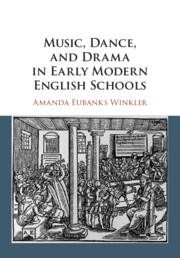Book contents
- Music, Dance, and Drama in Early Modern English Schools
- Music, Dance, and Drama in Early Modern English Schools
- Copyright page
- Dedication
- Contents
- Figures
- Tables
- Music Examples
- Preface
- Editorial Method
- Abbreviations and RISM Sigla
- Introduction
- 1 Situating Pedagogical Performance
- 2 Performing Piety
- 3 Performing Prestige
- 4 Performing Accomplishment
- 5 Performing Vice
- 6 Performing the Professional
- 7 Performing the Past: The Specter of the Schoolroom
- Bibliography
- Index
7 - Performing the Past: The Specter of the Schoolroom
Published online by Cambridge University Press: 14 May 2020
- Music, Dance, and Drama in Early Modern English Schools
- Music, Dance, and Drama in Early Modern English Schools
- Copyright page
- Dedication
- Contents
- Figures
- Tables
- Music Examples
- Preface
- Editorial Method
- Abbreviations and RISM Sigla
- Introduction
- 1 Situating Pedagogical Performance
- 2 Performing Piety
- 3 Performing Prestige
- 4 Performing Accomplishment
- 5 Performing Vice
- 6 Performing the Professional
- 7 Performing the Past: The Specter of the Schoolroom
- Bibliography
- Index
Summary
Performance studies scholar Joseph Roach has claimed that past performances never fully disappear; the act of performance might erase the distinction between past and present, as “the voices of the dead may speak … through the bodies of the living.” A recent performance of Henry Purcell’s Dido and Aeneas (2008) at the Opéra Comique in Paris with stage direction by Deborah Warner and musical direction by William Christie explored this temporal telescoping, as the production brought together Priest’s boarding school and the twenty-first-century professional opera stage through the bodies of young girls dressed in modern school uniforms. The girls did not sing as their forbearers did at Chelsea, but they charged onstage with unbridled energy, danced erratically, cavorted with a sailor, and mocked the main tragic plot. Warner’s stage direction allowed modern spectators to glimpse the spectral outline of early modern pedagogical performance as the children vividly revealed the ways in which singing, dancing, and acting bodies might engage with the text.
- Type
- Chapter
- Information
- Music, Dance, and Drama in Early Modern English Schools , pp. 195 - 207Publisher: Cambridge University PressPrint publication year: 2020

